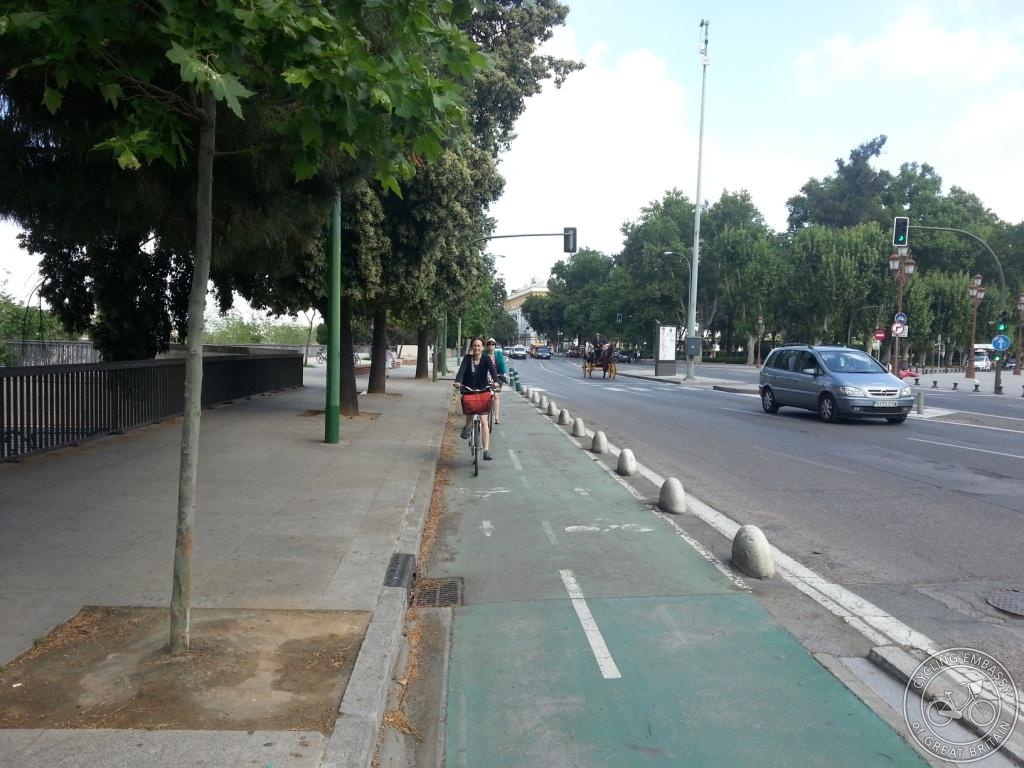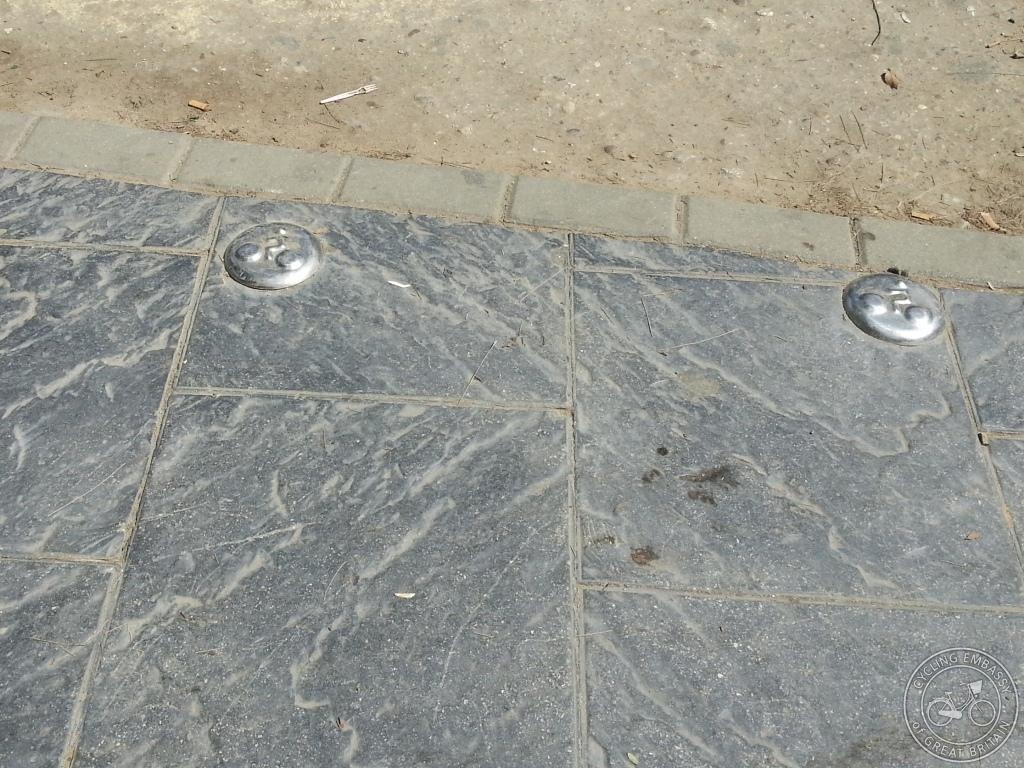Cycling in Seville - never mind the width, feel the network

Seville is the poster child of 'build it and they will come' - a city that built a bike network from scratch and in just a few years went from almost zero modal share to a not-at-all shabby 6% of journeys by bike. It's the example that cycle campaigners love to point to - something to inspire politicians and officials that it can be done. There have been many dissections of the background and the infrastructure - but what is it really like to cycle in as a city, and what are the lessons we can take from it?

As campaigners in Scotland (where the CAPS target of 10% of journeys by bike by 2020 is beginning to look unreachable without a Sevillian style shock-and-awe roll out of infrastructure everywhere, starting yesterday) we wanted to see and experience it for ourselves, along with some much-needed Spanish sunshine and a relaxing break after the rigours of organising both Pedal on Parliament and We Walk, We Cycle, We Vote. So the day after the local elections found myself, Lizzie Reather, Suzanne Forup and Claire Connachan rolling on the high speed AVE train from Madrid into the fabled Andalucian capital of cycling.

None of what follows is intended to be a rigourous examination of the Sevillian infrastructure - we did not get the measuring tapes out, or examine anything in too much detail. We were also very aware that pottering around a city on holiday - out of rush hour, not needing to get to any specific place, sticking largely to the city centre - can tend to flatter a city's cycling infrastructure. However, we did spend two days on bikes, exploring some of the outer reaches as well as the inner core, and talked to a couple of local cyclists as well to round out our impressions.

The first thing that stands out about Seville's cycle network is its visibility and subjective safety. The tracks are largely surfaced in green tarmac and well segregated from the motor traffic: we saw not a single lane where only paint separated you from passing cars. The only ASLs we saw appeared to be for motorbikes. Tracks were either raised to the level of the pavement (and sometimes only separated from pedestrians by rather subtle studs) or else protected by some serious concrete or metal bollards, including the 'lacasitos' (named after sweets a bit like Smarties, apparently).

Only once did we see the famous plastic armadillos, and that was on an out of town path passing through what was largely a car park. The tracks were either continuous across side roads, with drivers respecting the priority (reinforced by green tarmac), or there were signals to cross the bigger roads. We felt utterly safe using the network, and so apparently did the locals from the amount of texting, cigarette rolling and giving your mate a lift in the front basket they were doing on bikes - including one woman just riding along with her hands folded neatly in her lap.

The second thing is its connectivity. It was rare to find ourselves dumped out with nowhere safe to go (and the Sevillian response seems to be to just continue on the pavement, which is what we did too). Only within the historic heart of the city, bikes and cars share the roads, but these are very narrow and speeds are slow (even so, the locals we talked to felt that it was far too easy to drive in the historic centre, which they tended to avoid). It is obvious where you have to go, how you will cross the road and how to turn. The lovely See By Bike who rented us our steeds didn't feel the need to explain to us how to use the network and apart from the one bridge where the one-way cycle lanes are the 'wrong' way round it was largely extremely intuitive to use.

The third thing that stands out is that it is, by Dutch, Danish and Cycling Embassy standards generally, all a bit crap. There are trees in the middle of the tracks, they are too narrow for sociable cycling, the lights are slow, bends are too sharp and if there was a forgiving kerb anywhere we didn't notice it. There were a few nice touches - I was particularly taken by the wheelchair symbols on the bike lanes - and in fact the trees were extremely necessary in the heat of the afternoon to provide shade, even if they did get in the way a bit. However, objectively, there was much to find fault with.

There was also practically zero wayfinding - nobody seemed to have a city bike map (apart from one on a billboard in one of the city squares, apparently, although we never did find it), and very few signposts for bikes, although perhaps by building the tracks largely along the arterial roads this was less necessary than when taking more of a back streets approach. As it was, we were grateful for See By Bike's 'map of knowledge' (which had marked up on it not just the principal cycle routes, but also a short list of recommended restaurants and sights - and not one of them a dud either).

On the whole though, these details seemed to matter far less than you might think - as long as the connectivity and the segregation were there. We saw very few cyclists not using the lanes, even the most compromised ones, and at no point were we tempted to join the main roads ourselves. The main impact is to slow cyclists down, and to limit the capacity of the network. There were times when there simply wasn't room at the lights for pedestrians and cyclists and it was a bit of a scramble to get across when the lights went green without colliding with each other.
This may also explain why there were fewer kids cycling independently and cargo bikes than you might expect - although plenty of child seats. The few children we did see were struggling to maintain their lane, and rather than being able to cycle side-by-side, as Dutch families do, the main configuration was the more familiar UK one with the child in front being coached by a rather harassed parent behind - not a particularly relaxed experience.

There was also a fair bit of pragmatic rule breaking - the lights take ages (for cars and bikes alike) so the Sevillian way appears to be to wait until the way is clear and just go, as pedestrians would with the ‘green man’ at home. The very few one-way bike tracks (usually across bridges) were quite frequently being used as two-way tracks, although they were a bit narrow for that.
Talking to locals, it seems that - after stalling a bit when the city council changed hands - work has now resumed on extending the network both out to the outlying villages and into the older part of the city. The next obvious upgrade would be to widen the tracks that are there by converting them to one way tracks on both sides of the roads (and taking space from cars - some of these roads are absolutely massive). This will become more urgent as the network expands, encouraging more of the population onto bikes.

What lessons does Seville hold for campaigners in the UK? It's always dangerous to transplant approaches lock stock and barrel from one place to another. For instance, Seville was already using bollards to separate out cars from pedestrians and presumably keep pavements clear on narrow roads, so adding huge chunks of unforgiving concrete along a cycle lane works fine, whereas UK drivers who are used to more forgiving road furniture have not got on well when lacasitos have been trialled.

However, it does suggest that cities and governments who wish to bootstrap cycling from a low base should focus on connectivity, legibility and separation from cars above all - and worry about the rest later. This is perhaps unsurprising - after all, if we look at some of the older Dutch bike paths they too can be a bit 'crap' - while still managing to be a million miles better than most of what we have at home.
There’s a lesson too for politicians. Seville built its network because it was a requirement by a smaller party (in this case the Communists) to form an administration with a larger one. Local authorities are often run by coalitions of parties, so a smaller party could use similar leverage in the UK.
And is it really working as the boosters predict? We can hardly estimate modal share on what was effectively a holiday weekend (it being the last days of the Feria, the modal share for horse-drawn carriages was also startlingly high). But bike racks were full, people seemed happy to cycle in ordinary clothes, there were plenty of older people and others who did not fit the narrow demographic of those likely to cycle back in the UK. Cycling is also part of the mainstream tourist experience now - our giveaway map was advertising almost as many bike tours and rental places as flamenco performances, a sign that it has become part of what you do when visiting Seville.

In the UK, campaigners have been reluctant to trade off quality for connectivity - because too often here, 'low quality' means functionally useless paint on the road. However, I think the chief lesson from Seville is that once you have the basics in place - and the 'basics' mean safe and obvious separation from all but the slowest of traffic - then we should encourage local authorities and governments to build as much of it as they can for the money they have, even if that means less than perfect design on each individual stretch. We should also push back harder against spending money on anything that isn't the cycling network. Wayfinding won't create cyclists. Bike parking won't create cyclists. Footrests at traffic lights won't create cyclists. But a dense-enough, good-enough network will create cyclists - and that is the lesson to take from Seville

For a rather less formal description of our trip, you can see Lizzie Reather’s Storify https://storify.com/ereather/five-go-mad-in-seville
